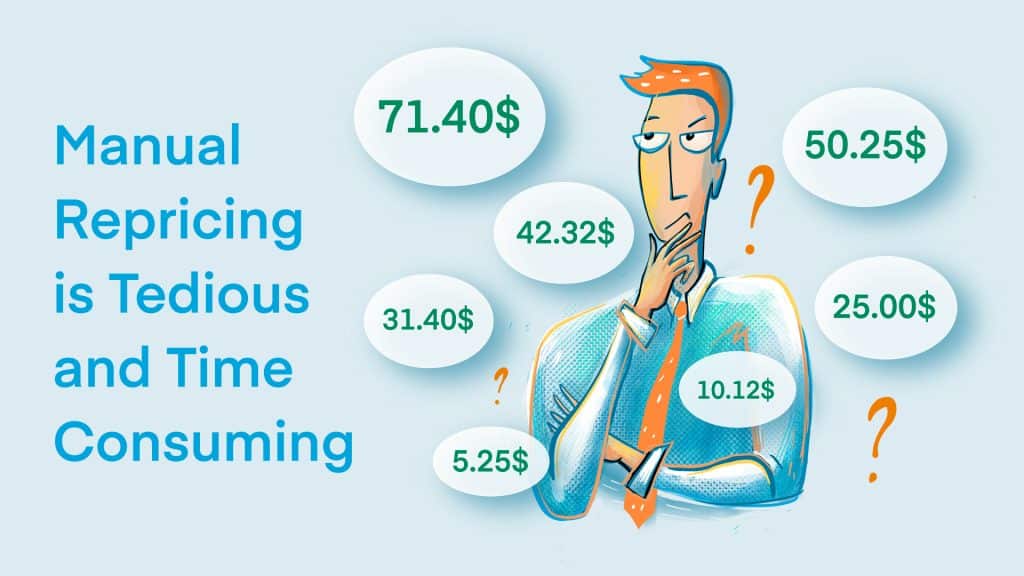
On third-party marketplaces, competition for the Buy Box can be fierce. If you can get it, your listing becomes the one ‘Buy Now,’ ‘Add to Cart,’ and virtual shopping assistant orders pulled from the Buy Box to fulfill customers’ purchases. Landing this coveted spot requires a lot of work (and the rules and algorithms vary by marketplace), but a competitive price is a major factor.
When multiple third-party sellers are offering the same product, marketplaces like Amazon and Walmart compare the total landed costs (the final price a customer pays after purchase, shipping, handling, and fees) of each listing to determine which listing(s) represent the best value for the customer. This means that while you don’t need to be the lowest price for a particular product for your listing to be featured, it certainly helps.
With new listings going live every day, earning the Buy Box can be as challenging as keeping it. Doing so involves long-term commitments to reliable fulfillment, consistent customer satisfaction, and responsive customer service. These boost your reputation and can help your ecommerce business appear to the powers as a reliable custodian of the Buy Box.
That said, these variables are tough to master in the short term. That’s where repricing comes in. Sellers need to monitor their landed cost figures and how they compare to their competitors’ offerings. Sometimes, all it takes is a penny’s difference for another seller to overtake your spot—either in the Buy Box or in the general pecking order of how your listing appears in marketplace search results. In most cases, doing this work manually ranges from tedious to downright impossible.
Manual Repricing Is Challenging
If you are relying on repricing your listings by hand to regularly undercut your competition, there are several issues you will likely run into:
Effective Repricing Must Take Into Account a Wide Variety of Variables
Settling on an optimal price for your listing is a multi-faceted proposition that evolves in real time. It is not as simple as scoring the lowest price point. For instance, you may be able to actually charge a bit more than a low-ball competitor due to a stronger marketplace reputation, greater inventory, and more reliable fulfillment. Trying to figure this out for every competitor on every one of your listings is a potential nightmare.
Manual Repricing Is Tedious and Time-Consuming
The labor costs associated with regularly assessing and updating your listings can add up quickly. As such, the return on investment you get from your efforts will likely be minimal. In some cases, the hours invested could even negate the benefits of repricing entirely.
You Are Likely to Overreact to Pricing Anomalies
For instance, you may find yourself reducing your prices to undercut a seller with limited inventory. Once they have sold their stock, you will be undercharging for your own inventory until you readjust your price.
The opposite scenario could also play out. In a time of limited competition, you may be able to increase your price when other sellers are out of stock. This can be a nice boost to your profit margin, but if other sellers swoop in and undercut you, you will likely see your sales dry up until you notice and make a correction.
Humans Make Mistakes
This is perhaps the biggest risk of manual repricing. Humans are susceptible to emotion and overreaction in ways that algorithms are not. It can be painful to reduce the price of a listing below what you think it is worth—even when doing so is the smart business decision. Similarly, trusting your gut on a pricing move without fully comprehending its impact could hamstring an otherwise successful listing.
Of course, manual data entry is, in itself, a major risk. A misplaced decimal or a mistyped digit could result in disastrous effects on your bottom line. Inventories priced too low could fly out of your warehouse, instantly multiplying the losses associated with the error. Listings priced too high could completely stagnate your sales and cost you your shot at the Buy Box.
If you take a DIY approach to repricing, every price change could be an opportunity for a costly error.

A Repricing Partner Allows You to Optimize Your Listings Safely and Efficiently
Repricers are invaluable partners for ecommerce sellers, particularly for sellers with lots of competition. When working with a repricer, you are transferring the responsibility of researching and adjusting the prices of your listings across their supported marketplaces. This saves you the time, worry, and frustration of manual, in-house repricing strategies.
The beauty of repricers is that they can synthesize a wide array of data to settle on pricing decisions in a way that is both faster and more comprehensive than what most people would be capable of doing on their own.
There are two major considerations most repricers use to price a listing. The first is competitor pricing. Repricers scour marketplace listings and determine price values that give you the best chance of securing the Buy Box. An algorithm analyzes other sellers’ pricing and landed cost figures to determine what (if any) pricing adjustment needs to be made to your listing.
If an adjustment needs to be made, the repricer makes it on your behalf. Depending on the repricer, these calculations can happen anywhere from several times a day to several times an hour.
The other factor repricers consider is a client’s acceptable minimum pricing threshold. The main benefit of threshold-based repricing is that it eliminates the risk of selling a product at a loss or a lower profit margin than you are comfortable with. Even if a repricer’s algorithm determines that you should sell for a certain price, if it is below the price floor you have set, no price change will cross that limit.
Repricers allow you to set rules based on set prices and/or cost-based formulas. For example, you can set a listing to never be repriced below $10. Alternatively, you could set a more complex rule, such as the price should always be set at the landed product cost plus 25%. These rules create safeguards so that no matter how frequently a price is adjusted, you can ensure your products are never undervalued in the shopping cart.
The combination of competitor- and threshold-based repricing means you can be confident that you are listing your merchandise at attractive prices and avoiding costly errors. Moreover, you are likely competing against other sellers already using repricing services. By choosing to price and reprice your listings manually, you are at a severe disadvantage.
The speed at which competitors’ listings adjust to your manual repricing moves dwarfs what can be done cost-effectively by hand. The benefits of a repricer are hard to argue with. When combined with the Descartes Sellercloud ecommerce growth platform, there are even more optimizations to unlock.
Descartes Sellercloud’s Repricer Integrations Make It Easy to Perfect Your Pricing Strategies
While Descartes Sellercloud users can already adjust prices on their listings from within the Descartes Sellercloud platform, many businesses opt to take advantage of our repricer integrations to further optimize the process. Your current Descartes Sellercloud product cost data can be used to establish minimum cost thresholds for each product.
This information can be synchronized with a repricer to ensure that you never reprice a listing below the combination of your current product cost and your minimum acceptable profit margin. As your product costs fluctuate, Descartes Sellercloud data can be shared with the repricing partner to automatically adjust listings across multiple marketplaces following these constraints.
Another major benefit to combining Descartes Sellercloud and a repricer is that it makes it easier to maintain compliance with Amazon’s pricing rules. One of the big no-nos in selling on Amazon is offering your product elsewhere for a lower price than what you are listing it for on Amazon.
Violating this rule can result in account suspension or other disciplinary action. This is a major risk, considering the costs of losing access to Amazon’s hundreds of millions of customers. Descartes Sellercloud protects you against this type of compliance violation by allowing you to use the lowest listing price of a product across all of your marketplace listings as the default price for your Amazon product listing.
This means that if your Walmart price is repriced below the current Amazon price, both will automatically synchronize to the new, lower price. This is just one more way Descartes Sellercloud offers users the ability to take advantage of repricer pricing strategies while maintaining peace of mind.
If you are ready to explore adding a repricer to your ecommerce business, read more on our wiki guide or contact us directly for more on how you can start optimizing your listings today.




